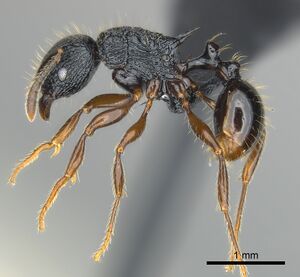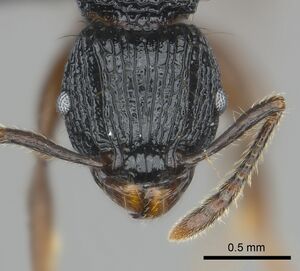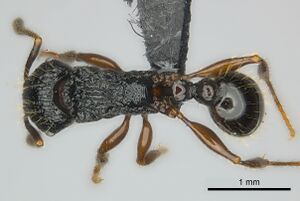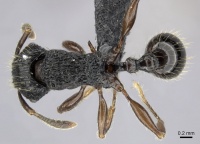Tetramorium yammer
| Tetramorium yammer | |
|---|---|

| |
| Scientific classification | |
| Kingdom: | Animalia |
| Phylum: | Arthropoda |
| Class: | Insecta |
| Order: | Hymenoptera |
| Family: | Formicidae |
| Subfamily: | Myrmicinae |
| Tribe: | Crematogastrini |
| Genus: | Tetramorium |
| Species: | T. yammer |
| Binomial name | |
| Tetramorium yammer Hita Garcia & Fisher, 2012 | |
Tetramorium yammer is only known from the type locality, the Parc National de Marojejy. It was collected from forest leaf litter in a montane rainforest habitat at 1325 m elevation.
Identification
A member of the Tetramorium dysalum-species group
Tetramorium yammer can be separated from all other group members by the following character set: short antennal scapes (SI 72 - 78); eyes small to moderate (OI 19 - 20); propodeal spines very long (PSLI 40 - 41); propodeal lobes very long and spinose; petiolar node squamiform with anterodorsal margin situated slightly higher than posterodorsal margin, dorsum tapering backwards posteriorly; dorsum of mesosoma with longitudinally arranged rugae; hairs on first gastral tergite erect or suberect. (Hita Garcia and Fisher 2012)
Keys including this Species
Distribution
Latitudinal Distribution Pattern
Latitudinal Range: -14.44333° to -14.44333°.
| North Temperate |
North Subtropical |
Tropical | South Subtropical |
South Temperate |
- Source: AntMaps
Distribution based on Regional Taxon Lists
Malagasy Region: Madagascar (type locality).
Distribution based on AntMaps
Distribution based on AntWeb specimens
Check data from AntWeb
Countries Occupied
| Number of countries occupied by this species based on AntWiki Regional Taxon Lists. In general, fewer countries occupied indicates a narrower range, while more countries indicates a more widespread species. |

|
Estimated Abundance
| Relative abundance based on number of AntMaps records per species (this species within the purple bar). Fewer records (to the left) indicates a less abundant/encountered species while more records (to the right) indicates more abundant/encountered species. |

|
Biology
Castes
Images from AntWeb
   
| |
| Paratype of Tetramorium yammer. Worker. Specimen code casent0499759. Photographer Estella Ortega, uploaded by California Academy of Sciences. | Owned by CAS, San Francisco, CA, USA. |
Nomenclature
The following information is derived from Barry Bolton's Online Catalogue of the Ants of the World.
- yammer. Tetramorium yammer Hita Garcia & Fisher, 2012: 88, figs. 88, 89, 125-127 (w.) MADAGASCAR.
Unless otherwise noted the text for the remainder of this section is reported from the publication that includes the original description.
Description
Worker
HL 0.88 - 0.94 (0.90); HW 0.89 - 0.95 (0.92); SL 0.67 - 0.74 (0.68); EL 0.17 - 0.19 (0.18); PH 0.46 - 0.52 (0.49); PW 0.66 - 0.72 (0.67); WL 1.16 - 1.30 (1.22); PSL 0.36 - 0.39 (0.37); PTL 0.16 - 0.18 (0.17); PTH 0.35 - 0.39 (0.37); PTW 0.27 - 0.31 (0.28); PPL 0.26 - 0.28 (0.27); PPH 0.34 - 0.39 (0.36); PPW 0.34 - 0.38 (0.35); CI 101 - 103 (102); SI 72 - 78 (74); OI 19 - 20 (20); DMI 51 - 57 (55); LMI 39 - 41 (40); PSLI 40 - 41 (41); PeNI 40 - 46 (42); LPeI 42 - 48 (46); DPeI 162 - 172 (166); PpNI 51 - 57 (53); LPpI 71 - 79 (75); DPpI 124 - 134 (130); PPI 121 - 130 (125) (ten measured).
Head wider than long (CI 101 - 103). Anterior clypeal margin with distinct median impression. Frontal carinae well-developed, usually ending at posterior head margin. Antennal scrobes narrow, shallow, and faint. Antennal scapes short, not reaching posterior head margin (SI 72 - 78). Eyes comparatively small (OI 19 - 20). Mesosomal outline in profile comparatively flat, moderately marginate from lateral to dorsal mesosoma, promesonotal suture and metanotal groove absent; mesosoma comparatively stout, high, and compact (LMI 39 - 41). Propodeal spines very long, spinose and acute (PSLI 40 - 41); propodeal lobes very long, spinose, and acute. Petiolar node in profile squamiform and anteroposteriorly compressed, approximately 2.2 to 2.3 times higher than long (LPeI 42 - 48), anterior and posterior faces almost parallel, anterodorsal margin situated slightly higher than posterodorsal margin, dorsum weakly tapering backwards posteriorly; node in dorsal view approximately 1.6 to 1.7 times wider than long (DPeI 162 - 172). Postpetiole in profile rounded, approximately 1.2 to 1.4 times higher than long (LPpI 71 - 79), in dorsal view 1.2 to 1.4 times wider than long (DPpI 124 - 134). Postpetiole in profile slightly more voluminous than petiolar node, in dorsal view approximately 1.2 to 1.3 times wider than petiolar node (PPI 121 - 130). Mandibles distinctly striate; clypeus with strong median longitudinal ruga and one or two weaker rugulae at each side; cephalic dorsum between frontal carinae with seven to nine longitudinal rugae, rugae running to posterior head margin, few rugae broken or with cross-meshes; lateral and ventral head with reticulate-rugose to longitudinally rugose sculpture; ground sculpture on head usually faint. Mesosoma laterally with irregular longitudinal rugae; mesosomal dorsum longitudinally rugose, rugae often meandering and with cross-meshes, still distinctly longitudinally arranged. Petiole and postpetiole almost unsculptured with few weak rugulae. Gaster unsculptured, smooth and shining. All dorsal surfaces of body with abundant, long, erect or suberect pilosity. Head, mesosoma, waist segments, and gaster very dark brown to black, appendages often of lighter colour.
Type Material
Holotype worker, MADAGASCAR, Antsiranana, Parc National de Marojejy, Antranohofa, 26.6 km 31° NNE Andapa, 10.7 km 318° NW Manantenina, 14.44333 S, 49.74333 E, 1325 m, montane rainforest, sifted litter (leaf mold, rotten wood), collection code BLF9080, 18.XI.2003 (B.L. Fisher) (California Academy of Sciences: CASENT0042832). Paratypes, one worker with same data as holotype (BMNH: CASENT0042886); and 18 workers with same data as holotype except sampled ex rotten log and collection codes BLF9175 and BLF9189 (CASC: CASENT0499759, CASENT0499760, CASENT0499761, CASENT0499777, CASENT0499781; Musee d'Histoire Naturelle Genève: CASENT0499778).
Etymology
The new species is dedicated to George Zachary for his support to discover and identify life on earth, and we have named it after his company "yammer".
References
References based on Global Ant Biodiversity Informatics
- Garcia H. F. and B. L. Fisher. 2012. The ant genus Tetramorium Mayr (Hymenoptera: Formicidae) in the Malagasy regiontaxonomy of the T. bessonii, T. bonibony, T. dysalum, T. marginatum, T. tsingy, and T. weitzeckeri species groups. Zootaxa 3365: 1-123

